Discover the Most Common Birds of Prey Found in Texas
Updated: 20 Mar 2024
36

Texas is home to a diverse array of birds of prey, also known as raptors, which are renowned for their keen eyesight, powerful talons, and impressive hunting abilities. From the iconic Bald Eagle to the agile Cooper’s Hawk, these magnificent predators play a crucial role in maintaining ecological balance throughout the state.
However, hawks face numerous threats, including habitat loss, pollution, collisions with man-made structures, and illegal hunting. Urbanization and pesticide use further exacerbate these challenges, endangering hawk populations across the state.
Join us as we journey through the skies of the Lone Star State, exploring the habitats, behaviors, and unique adaptations of Texas’ birds of prey. Learn about their roles in the environment and the importance of conserving these magnificent creatures for future generations.
Here is a list of birds of prey found in Texas:
1. Osprey
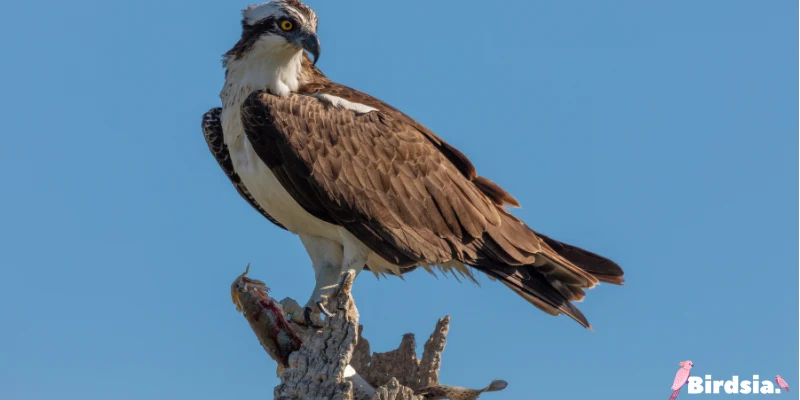
The Osprey is a remarkable bird of prey found in Texas, known for its impressive fishing abilities and migratory behavior. With its large size and distinctive appearance—featuring a white head and dark brown body—the osprey is easily identifiable as it soars through the skies. Equipped with keen eyesight and powerful talons, it can spot and capture fish from great heights with remarkable precision.
Witnessing the osprey in action is a sight, as it plunges into the water with incredible speed to catch its prey. Its agility and hunting prowess make it a dominant predator in the vast landscapes of Texas, showcasing the remarkable adaptability and survival skills of these majestic raptors.
Measurement of Osprey (Pandion haliaetus):
- Length: 21.7–23.6 inches
- Weight: 49.4–70.5 ounces
- Wingspan: 59.1–70.9 inches
2. Bald Eagle
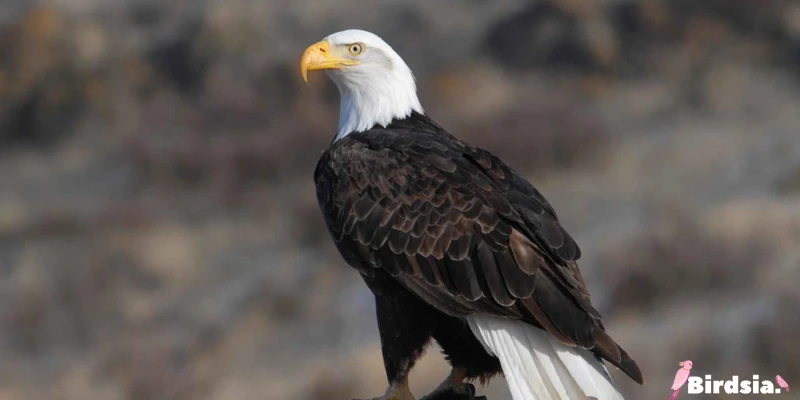
In the vast Texas skies, the majestic bald eagle, symbolizing strength and freedom, is a frequent sight. Scientifically known as Haliaeetus leucocephalus, this magnificent bird of prey has an impressive white head and tail contrasting with its brown body. Here are some fascinating details about bald eagles in Texas:
- Bald eagles can have a wingspan of up to 7 feet.
- They glide effortlessly through the air, using their keen eyesight to spot prey like fish or small mammals from great distances.
- Bald eagles construct large nests, called eyries, in tall trees near bodies of water.
- They raise their young in these nests.
- Despite their name, bald eagles aren’t bald; instead, the term “bald” originates from the Old English word “balde,” meaning white.
- This describes their distinctive white head and tail feathers.
Measurement of the Bald Eagle (Haliaeetus leucocephalus):
- Length: 28–40 inches
- Weight: 6.6–14 pounds
- Wingspan: 6–7.5 feet
3. Black Vulture
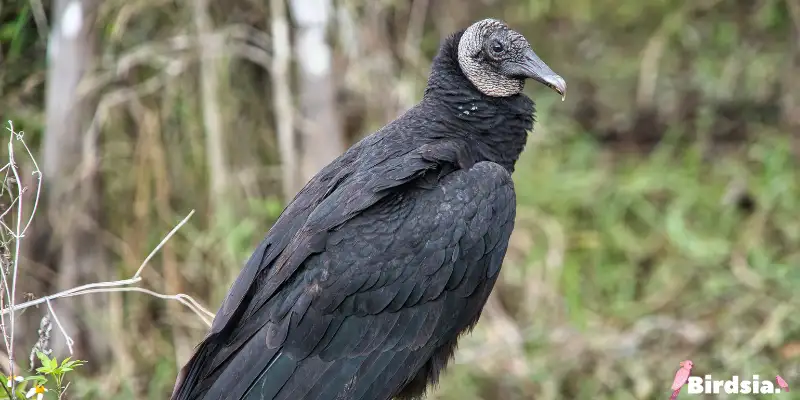
Black vultures are a common sight in Texas, soaring high in the sky with their sleek black feathers. They play a vital role in nature by cleaning up carrion, which helps recycle nutrients in the ecosystem. These birds have impressive wingspans of about 5 feet and can glide effortlessly on air currents while using their keen sense of smell to find food. While they mostly eat dead animals, they also hunt small mammals like rabbits and rodents when they get the chance.
Black vultures are tough and adaptable, living in forests, grasslands, and even cities across Texas. Their ability to thrive in different environments shows how resilient they are. Overall, black vultures are crucial for keeping Texas’s ecosystems healthy by cleaning up dead animals and showing how everything in nature is connected.
Measurement of the Black Vulture (Coragyps atratus):
- Length: 24-27 inches
- Weight: 3-5 pounds
- Wingspan: 54–60 inches
4. Turkey Vulture
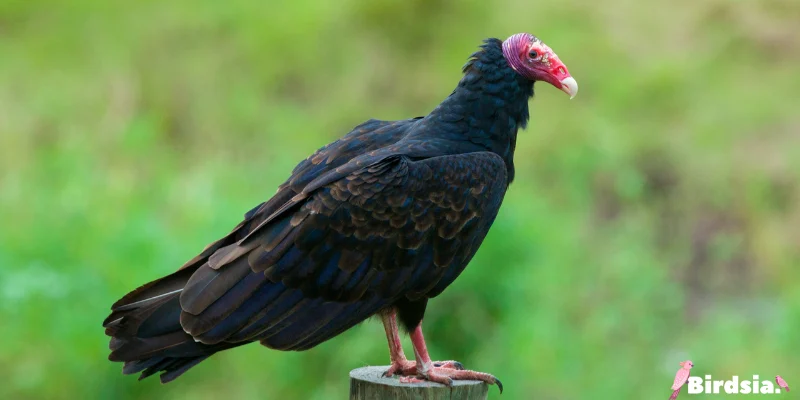
With a wingspan reaching about 6 feet, the Turkey Vulture is a notable presence in Texas’s diverse ecosystems. They have bald red heads and dark brown feathers; they’re skilled scavengers often seen perched on trees or poles, scanning for carrion below. While they mostly feed on dead animals, they may also catch small birds or steal from other predators.
Despite their size, Turkey’s Vultures are not aggressive and prefer to avoid conflicts. Their flight patterns may resemble hawks, but their red heads and bare necks set them apart. Overall, Turkey Vultures play a crucial role as nature’s cleanup crew, maintaining the balance of life and death in Texas’s wilderness.
Measurement of Turkey Vulture (Cathartes aura):
- Length: 25-32 inches
- Weight: 3-5 pounds
- Wingspan: 63-72 inches
5. Golden Eagle

Golden eagles, with their majestic brown plumage and impressive hunting abilities, are a common sight in the vast landscapes of Texas. These magnificent raptors, boasting wingspans of up to seven feet, navigate the skies with unparalleled grace. They are skilled hunters, using their sharp talons to capture prey efficiently.
While they primarily target small mammals like rabbits and ground squirrels, they are capable of taking down larger prey such as deer and pronghorn. Their adaptability in hunting strategies makes them formidable predators across various landscapes. Often found near large bodies of water, golden eagles play a vital role in maintaining the balance of Texas’s ecosystems as keystone species.
Measurement of the Golden Eagle (Aquila chrysaetos):
- Length: 26–40 inches
- Weight: 6.6–15.4 pounds
- Wingspan: 5.9–7.7 feet
6. Peregrine Falcon

The Peregrine Falcon is known for its incredible speed and agility, making it a skilled hunter across Texas. It’s a bit larger than the common Broad-winged Hawk, with a wingspan of about 3 feet, and you can often see it soaring through the skies all year in Texas.
This falcon is adaptable and can live in different places, from forests to grasslands and even cities. While it mainly eats other birds, it’s also been seen around bird feeders, showing it can be flexible in its food choices.
Overall, the Peregrine Falcon is an important part of Texas’s wildlife, helping to keep balance in its ecosystems.
Measurement of the Peregrine Falcon (Falco peregrinus):
- Length: 14.2–19.3 inches
- Weight: 18.7–56.4 ounces
- Wingspan: 39.4–43.3 inches
7. American Kestrel
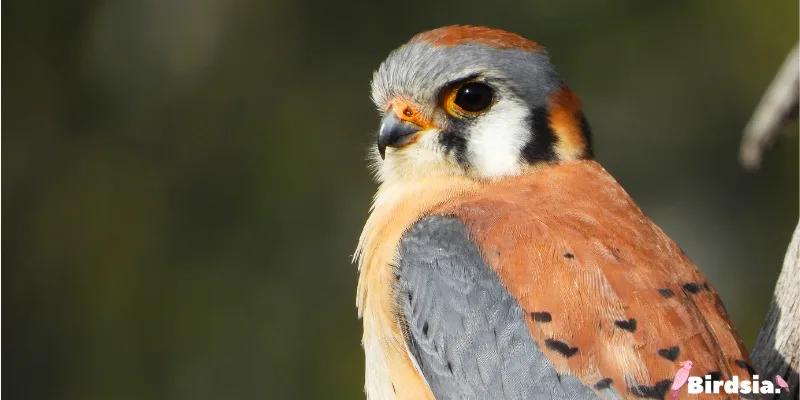
The American Kestrel is a small but mighty predator that can be seen all across Texas. With their vibrant blue-gray wings, rusty back, and white underbelly dotted with black spots, the males are a stunning sight against the Texas sky. Females have a more muted coloration but are just as impressive.
These kestrels are skilled hunters, using their sharp beaks and talons to catch a variety of prey like insects, small mammals, birds, and even reptiles. Their agility in flight and hunting abilities make them a key part of Texas’ ecosystem, helping to maintain the balance of nature.
Measurement of the American Kestrel (Falco sparverius):
- Length: 8.7–12.2 inches
- Weight: 2.8–5.8 ounces
- Wingspan: 20.1-24.4 inches
8. Sharp-Shinned Hawk
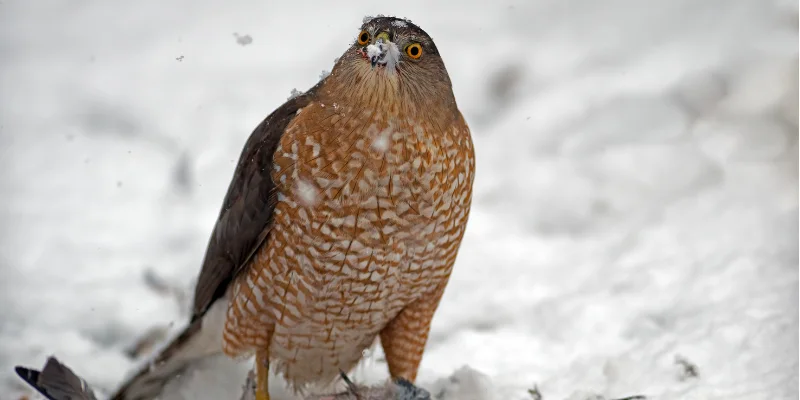
The Sharp-Shinned Hawk may be small compared to other hawks, but it’s a skilled predator in the Texas landscape. With its sharp talons and beak, this bird is known for its impressive hunting abilities.
Measuring around 10–14 inches in length and with a wingspan of 20–27 inches, the Sharp-Shinned Hawk prefers wooded areas and forests where it can navigate through dense vegetation to hunt its prey.
It’s highly agile and adept at aerial pursuits, often targeting small birds and mammals. While sightings in Texas are common during migration seasons, some Sharp-Shinned Hawks make the state their year-round home, adding to the diversity of Texas’ ecosystem.
Measurement of the Sharp-Shinned Hawk (Accipiter striatus):
- Length: 10–143.1–7.7 inches
- Weight: 3.1–7.7 ounces
- Wingspan: 20-27 inches
9. Red-Tailed Hawk
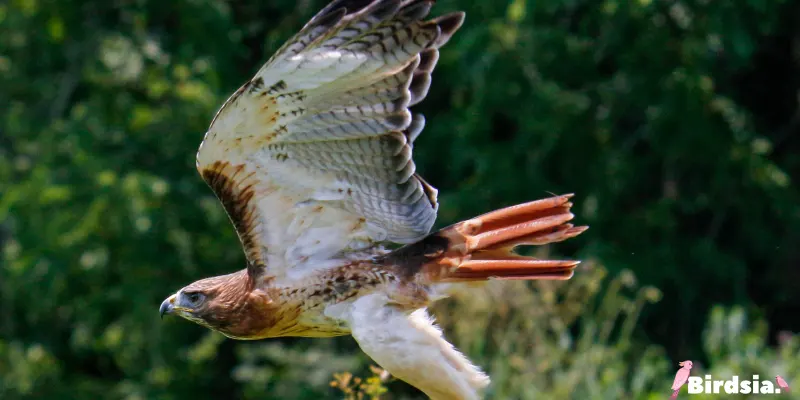
A familiar sight across the expanses of Texas, the Red-Tailed Hawk stands as an emblematic figure among the state’s avian residents, distinguished by its striking appearance and impressive aerial prowess. Here are some notable attributes and behaviors of this magnificent bird of prey:
- The Red-Tailed Hawk is a majestic bird of prey in Texas.
- It is known for its impressive wingspan of up to four feet.
- Its plumage is mostly brown, but its reddish-brown tail feathers give it its name.
- With sharp talons and a hooked beak, it’s a skilled predator.
- The Red-Tailed Hawk hunts small mammals, birds, and reptiles.
- Using its keen eyesight and instincts, it surveys its surroundings from high above.
- It swoops down with precision to catch its prey.
- These hawks are vital to Texas’ ecosystem.
- They contribute to its rich biodiversity and help maintain ecological balance.
Measurement of the Red-Tailed Hawk (Buteo jamaicensis):
- Length: 17.7–25.64 inches
- Weight: 24.3-51.5 ounces
- Wingspan: 44.9–52.4 inches
10. Prairie Falcon
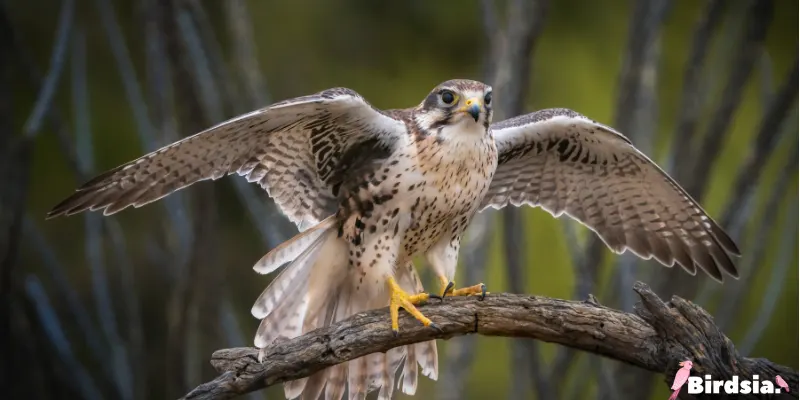
Amidst the sweeping plains and boundless skies of the Texan prairies, the Prairie Falcon reigns as a formidable predator, showcasing its remarkable prowess and adaptability within the central regions of Texas. Here are some notable characteristics and behaviors that define this magnificent bird of prey:
- With agile wings and a sleek physique, the Prairie Falcon navigates the skies with precision, executing breathtaking aerial acrobatics as it hunts with determination.
- Sporting plumage that blends into the grasslands, the Prairie Falcon uses natural camouflage to stalk prey stealthily.
- Equipped with sharp talons, the Prairie Falcon secures successful hunts with calculated strikes.
- The Prairie Falcon migrates southward during colder months in search of temperate climates and abundant food sources.
- The presence of the Prairie Falcon highlights Texas’ avian biodiversity and underscores its role in maintaining ecosystem balance.
Measurement of the Prairie Falcon (Falco mexicanus):
- Length: 14.6–18.5 inches
- Weight: 19.8–36.7 ounces
- Wingspan: 35.4–43.3 inches
11. Cooper’s Hawk

Cooper’s Hawks are pretty common in Texas, especially in winter, making up about 6% of checklists during that time.
Their numbers peak during the winter months, from September to March, coinciding with the migration of birds from northern breeding territories.
Identifying Cooper’s Hawks from similar species like Sharp-shinned Hawks can be tricky, as they share a blue-gray back and a red-orange breast with dark bands on their tails. However, Cooper’s Hawks are larger, about the size of a crow, with a more prominent head that extends beyond their wingspan.
While many Cooper’s Hawks stay year-round in Texas and other parts of the United States, some migrate southward during the winter, reaching as far as Mexico and Honduras, contributing to the diversity of their wintering areas.
Measurement of Cooper’s Hawk (Accipiter cooperii):
- Length: 14.6–18.1 inches
- Weight: 7.8–24.0 ounces
- Wingspan: 24.4–35.4 inches
12. Broad-Winged Hawk

The Broad-Winged Hawk is a striking raptor often seen soaring over the skies of Texas. It’s known for its short, broad wings, broad tail, and crest atop its head, giving it a majestic look. This hawk has rich brown plumage with a white belly and prominent white bands on its tail feathers.
Found mainly in central and southern Texas, it’s a skilled hunter, preying on small animals like rodents and reptiles. The Broad-Winged Hawk plays a crucial role in the ecosystem by helping control the populations of these animals, contributing to the balance of nature in Texas.
Measurement of Broad-Winged Hawk (Buteo platypterus):
- Length: 13.4-17.3 inches
- Weight: 9.3–19.8 ounces
- Wingspan: 31.9–39.4 inches
13. Northern Harrier
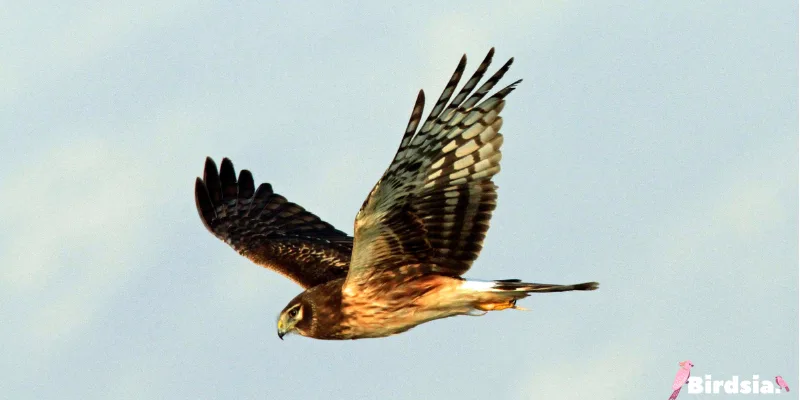
Northern Harriers are indeed fascinating birds of prey, distinguished by their unique hunting techniques and distinctive appearance. Unlike many other hawks, Northern Harriers rely not only on their exceptional eyesight but also on their acute hearing to locate prey, a trait shared with owls. Their disc-shaped face further enhances their ability to detect sounds, resembling the facial structure of owls.
To observe Northern Harriers in their natural habitat, one must venture into open grasslands, fields, or marshes, where these birds prefer to hunt. Recognizable by their slender build, long tails, and distinctive white rump patch, Northern Harriers can often be observed flying low over their hunting grounds, scanning the landscape for potential prey.
The Northern Harrier’s unique hunting behavior and specialized adaptations make it a captivating species to observe and study in the wild. By utilizing both sight and sound to locate prey, these birds exemplify the remarkable diversity and adaptability of avian predators in the USA.
Measurement of the Northern Harrier (Circus Hudsonius):
- Length: 18.1–19.7 inches
- Weight: 10.6-26.5 ounces
- Wingspan: 40.2-46.5 inches
14. Great Horned Owl

The Great Horned Owl, a majestic nocturnal predator, holds a prominent place among Texas’ birds of prey. It has a large size and distinct ‘horned’ tufts of feathers. It is often found perched high in trees, silently awaiting its prey under the cover of darkness.
With a wingspan of up to 5 feet, it maneuvers through the night sky with stealth and precision, making it a formidable hunter. Armed with sharp talons, it preys on a variety of animals, showcasing its adaptability and resourcefulness. Thriving in diverse habitats, from forests to deserts, the Great Horned Owl embodies the resilience and adaptability of wildlife in Texas.
Measurement of the Great Horned Owl (Bubo virginianus):
- Length: 18.1 to 24.8 inches (46 – 63 cm)
- Weight: 32.1 to 88.2 ounces (910 – 2500 g)
- Wingspan: 39.8 to 57.1 inches (101 – 145 cm)
15. Barn Owl

Barn Owls are beloved residents of Texas all year round, often seen from October to April. They have white, heart-shaped faces and dark eyes, making them charming to bird enthusiasts.
These owls don’t migrate, preferring to stay in various habitats like forests, farmlands, and even cities. During the day, they roost in hollow logs or barns. At night, their acute hearing helps them hunt small mammals like rats and voles, as well as birds and insects.
After eating, Barn Owls regurgitate pellets containing undigested parts of their prey, giving us insight into their diet and habits. They’re cherished for their unique appearance and the joy they bring to birdwatchers across Texas.
Measurement of Barn Owl (Tyto alba):
- Length: 12.6–15.8 inches (32–40 cm)
- Weight: 14.1-24.7 ounces (400-700 grams)
- Wingspan: 39.4–49.2 inches (100–125 cm)
Common Hawk Species Found in Texas:
Texas boasts a remarkable diversity of hawk species, showcasing the state’s vibrant avian ecosystem. These majestic birds of prey are a common sight across Texas, particularly during the winter months, when they migrate to the state in search of food and suitable nesting sites. For bird watchers and nature enthusiasts alike, Texas offers a unique opportunity to observe and study these magnificent creatures in their natural habitats. Here are some of the hawk species commonly found in Texas:
Cooper’s Hawk:
This medium-sized hawk is renowned for its swift flight and remarkable agility, enabling it to hunt down small birds and mammals with precision.
Red-tailed Hawk:
With its iconic red tail, this hawk species is a familiar sight in Western Texas, where it soars majestically above the open grasslands in pursuit of prey.
Northern Harrier:
Also known as the Marsh Hawk, this distinctive hawk species frequents wetlands and prairies, where it hunts for small mammals and birds with its keen eyesight and stealthy approach.
Harris’s Hawk:
This unique hawk species is notable for its social behavior, often hunting cooperatively in groups and displaying remarkable teamwork to capture prey.
Red-shouldered Hawk:
Recognizable by its distinctive reddish-brown shoulders, this hawk species inhabits wooded areas and forests, where it preys on small mammals, birds, and reptiles.
Swainson’s Hawk:
Known for its elegant flight and graceful appearance, this hawk species is commonly seen in Texas during migration seasons, where it feeds on insects and small rodents.
From the swift Cooper’s Hawk to the iconic Red-tailed Hawk and the cooperative Harris’s Hawk, Texas offers a haven for bird watchers, providing unparalleled opportunities to witness the fascinating behaviors and diverse adaptations of these remarkable hawk species.
Conservation Efforts for Birds of Prey:
Conservation efforts for birds of prey, also known as raptors, are crucial due to the various threats they face in the wild. Here are some common conservation strategies:
Habitat Protection and Restoration:
Protecting and restoring the natural habitats of birds of prey is fundamental to their survival. This includes preserving nesting sites, such as cliffs and trees, and ensuring the availability of suitable hunting grounds.
Legal Protection:
Implementing and enforcing laws and regulations that protect birds of prey from activities such as hunting, trapping, and habitat destruction is essential. This often involves designating certain species as protected or endangered and imposing penalties for harming them or disturbing their habitats.
Monitoring Populations:
Regular monitoring of bird of prey populations helps conservationists track changes in numbers and distribution, identify threats, and evaluate the effectiveness of conservation measures.
Research and Data Collection:
Conducting scientific research to better understand the ecology, behavior, and threats facing birds of prey is crucial for developing effective conservation strategies. This includes studying their migration patterns, reproductive biology, and interactions with other species.
Raptor Rescue and Rehabilitation:
Establishing facilities and programs for rescuing, rehabilitating, and releasing injured or orphaned birds of prey back into the wild helps mitigate the impact of human-related threats such as collisions with vehicles or buildings, poisoning, and electrocution.
Education and Outreach:
Raising awareness among the public about the importance of birds of prey and the threats they face can foster support for conservation efforts. Educational programs, workshops, and outreach initiatives aimed at schools, communities, and stakeholders can help promote appreciation and conservation of these birds.
Mitigating Human-Induced Threats:
Implementing measures to reduce or eliminate threats posed by human activities is crucial for bird of prey conservation. This may include installing bird-friendly infrastructure such as power line markers to prevent collisions, using alternatives to harmful pesticides that can poison birds, and promoting responsible tourism and outdoor recreation practices.
International Cooperation:
Since many birds of prey are migratory and may traverse multiple countries during their annual migrations, international cooperation is essential for their conservation. Collaborative efforts among countries to protect critical habitats, regulate hunting and trade, and address other transboundary conservation issues are essential for the long-term survival of these species.
By implementing these conservation strategies, we can help ensure the survival of birds of prey and maintain healthy ecosystems where they play vital roles as top predators.
Challenges and Threats Facing Birds of Prey
Habitat loss and degradation pose a significant threat to birds of prey in Texas, including iconic species like the Bald Eagle and Peregrine Falcon. Loss of suitable habitats deprives them of resources and disrupts their hunting behaviors. Pesticide use and collisions with man-made structures further endanger their populations.
Conservation efforts should focus on habitat conservation and restoration, reducing pesticide use, and mitigating the impacts of structures like power lines. Proactive measures are essential to safeguarding the future of birds of prey in Texas and ensuring their continued thriving in the wild.
Final Thought:
Birds of prey, or raptors, are integral components of Texas’ diverse ecosystems, contributing to the state’s rich biodiversity and ecological balance. From the majestic Bald Eagle soaring over the open skies to the stealthy Great Horned Owl hunting under the cover of darkness, these magnificent creatures captivate and inspire us with their beauty, grace, and hunting prowess.
However, despite their importance, birds of prey in Texas face numerous threats, including habitat loss, pollution, collisions with man-made structures, and illegal hunting. Addressing these challenges requires concerted conservation efforts, ranging from habitat protection and restoration to legal protection, monitoring populations, and mitigating human-induced threats.
By implementing proactive conservation strategies and fostering public awareness and appreciation for birds of prey, we can ensure their survival for generations to come. Together, let us strive to safeguard the future of these magnificent creatures and preserve the natural heritage of Texas for all to enjoy.
What is the common bird of prey in Texas?
The most common bird in Texas, based on breeding bird surveys, is the Northern Cardinal. Other common backyard and wild birds in Texas include the Northern Mockingbird, Mourning Dove, White-winged Dove, Carolina Chickadee, Carolina Wren, and Blue Jay. These birds are frequently observed across various habitats in Texas, from urban areas to rural landscapes, making them familiar sights to residents and birdwatchers alike.
What is the largest hawk in Texas?
The Ferruginous Hawk, North America’s largest hawk, boasts a formidable presence with its stout build and piercing gaze. Its brown upperparts, streaked with rust, and white underparts provide effective camouflage on its hunting grounds.
What is the gray bird of prey in Texas?
The Gray Hawk, a tropical species, occasionally ventures into Arizona and Texas. With its elegant raincloud-gray plumage and finely barred underparts, it glides gracefully over open landscapes or perches in cottonwoods, willows, and mesquites near lowland streams.
What are the largest birds in Texas?
Whooping cranes, towering at nearly 5 feet (1.5 m) tall, hold the title of the tallest birds in North America. With a wingspan stretching 7.5 feet (2.3 m), they command the skies with impressive grace and majesty.
Please Write Your Comments